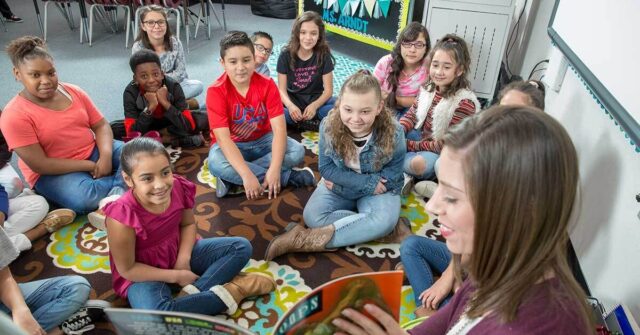
Amplify: Digital Teaching and Learning in the K–6 Classroom by Kristin Ziemke and Katie Muhtaris is out this week! Amplify does exactly what the title implies. "When introducing technological tools, we often apply the same practices and strategies we use in our daily teaching, but amplify their power with technology,” write Katie and Kristin. “We model what we want students to do with the technology, guide them to try it out with us, provide time for practice, then share as a class.” As part of our previews leading to the book's publication, we're providing the inspired and reverent foreword from the book, written by Stephanie Harvey.
Foreword by Stephanie Harvey
[dropcap]Welcome[/dropcap] to Amplify! As you will discover, this book totally rocks! Full of passionate and practical ideas for enhancing your teaching with technology, it stakes a rock-solid claim, grounded in research, for amplifying proven, constructivist teaching and learning strategies with technology. As Katie and Kristin make clear, it’s not the technology but what we do with it that augments teaching and learning. “As digital tools became more and more present in our classrooms, we wanted to shy away from many of the practices that didn’t make sense. Just because we can do something innovative, doesn’t always mean we should.” We get it. We’ve all seen the far-too-prevalent smartboards loaded with lame software that convert screens into fill-in-the-blank worksheets, or iPads stuffed with mind-numbing apps that differ little from the ditto packets reproduced in the copy rooms of yesteryear. You won’t find them in this book. Amplify shares the collaborative journey of these two energetic risk takers as they open up their teaching and their kids’ learning through the thoughtful use of technology. This book can help anyone who picks it up do the same. It certainly has me.
A number of years ago, I had the good fortune of working in Katie’s and Kristin’s classrooms at Burley School, in the Chicago Public Schools. Together with Smokey Daniels, principal Barbara Kent, and the amazing Burley staff, we worked to implement and sustain a school-wide, thoughtful, collaborative inquiry approach. Subsequent instructional videos featured Katie, Kristin, and their colleagues demonstrating extraordinary inquiry-based teaching. But technology was sparse. Katie, a born techie, had laptops in her room but little else. Kristin would peek in, curious about how tech platforms might enhance the learning in her first-grade classroom, but not entirely convinced. Together with their future-thinking tech whiz, Carolyn Skibba, they wrote and won an iPad grant and expanded on that over the next few years until their classrooms were “one-to-one,” an iPad for every child.
Just as Katie and Kristin fanned the flame of their kids’ learning, they lit mine up too.
But Katie and Kristin understood tech specialist Alan November’s caution that one-to-one is a misnomer, that when we add devices it’s one-to-world! Their kids were soon backchanneling with scientists in Antarctica, soliciting ideas from kids in Bremen, Germany on the best classroom pets, and getting global perspectives on climate change. Their contagious energy and passion lit up their one-to-world classrooms and ignited their kids’ engagement and learning.
Just as Katie and Kristin fanned the flame of their kids’ learning, they lit mine up too. And this book will light up yours. It’s a perfect mix of theory and practice. Katie and Kristin know their stuff, and they fill us in on the research-based rationale for merging solid pedagogy with technology. But they also know that teachers need practical ideas for doing this work. At the end of chapters, they offer three things you can try tomorrow. How great is that! They share popular hashtags, apps, and websites for educators. They open up their minilesson structure and let you in on what a typical week can look like. In the independence chapter, they discuss the increasingly important idea of digital citizenship, the power of audience, and how to manage devices responsibly.
Most important, throughout the book they honor Don Graves’ notion that teachers are the chief learners in the classroom. They recognize that the best teachers learn along with and also from their kids in all things but especially relative to technology. This kind of learning reveals a powerful way for kids to see that adults never stop trying new things, perhaps messing up, and ultimately learning from their attempts and from one another. Katie and Kristin also stress the power of collaboration among colleagues as they march forth on their pedagogical/technological expedition.
A lasting feature of this book is the ongoing discussion of what technology should and should not be. Katie and Kristin remind us that tech is not a silver bullet and does not supplant our traditional tools. They continue to put sticky notes and clipboards on their supply list. They don’t abandon books or paper and pencils. They encourage a balance of digital text and print text, reminding us not to ignore print simply because tech is ubiquitous. Their kids read, write, and interact around conventional print, as well as digitally. Amplify builds a much needed bridge between powerful, research-based pedagogy and thoughtful technology use. Ultimately, this book urges us to open up a world of possibilities by giving our kids the widest possible range of tools, texts, and opportunities for learning and wondering. Enjoy the ride. It’s thrilling!


